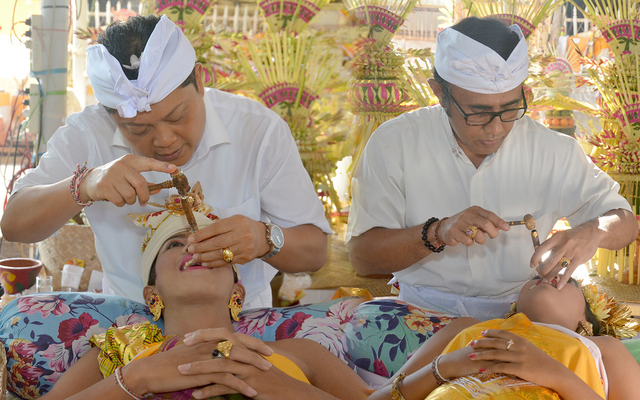
For a person unfamiliar with Balinese culture, information about tooth filing in Bali can be shocking at worst and puzzling at best. Yes, this ancient ritual has survived to our times, and almost all Balinese people still undergo it.
There are several names for this ceremony. Some call it "matatah" (matatah), derived from the Balinese word "natah" - to carve. In formal Balinese language, it is referred to as "mapandes" or "masanggih," both derived from the word "sangih" - to file. Accordingly, the person performing this procedure is called "sangging" (sangging).
Tooth filing, along with prenatal and natal ceremonies, rituals for infants, and weddings, belong to the category of manusia yajna rituals that accompany a person throughout their life. Among them, there are five most important ones - Pancha Yajna, which every Balinese individual must undergo to ensure the proper passage of their spirit from birth to death and further reincarnation.
One of the most auspicious times for tooth filing is the moment of reaching maturity, which, for girls, marks the onset of menstruation, and for boys, the time when their voice changes. The tooth filing ceremony signifies that the participant is entering adulthood.
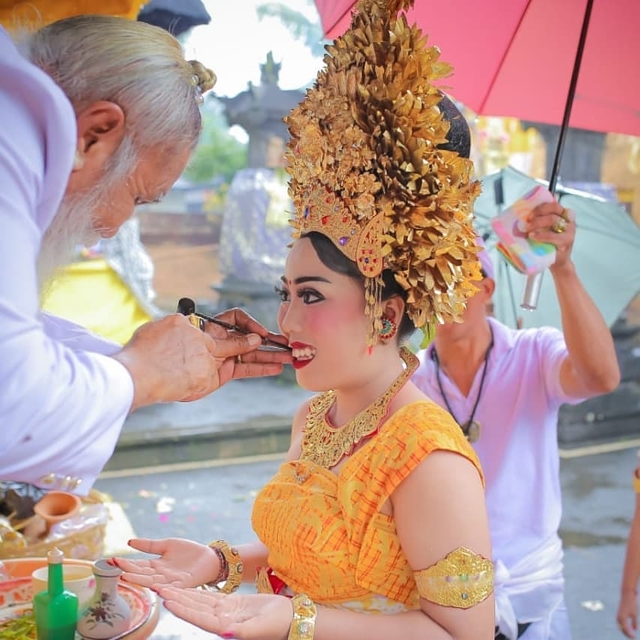
But if a family doesn't have enough money to organize this ritual, they postpone it. For example, until a wedding or even later. In earlier times, it used to happen that a person would pass away without their teeth filed, and in such cases, the matatah ceremony had to be performed on the deceased.
However, the religious council of Bali, Parisada Hindu Dharma Indonesia Pusat, decided that performing the tooth filing ceremony on the deceased is not obligatory.
Why is matatah so important and what is the essence of this operation?
Balinese people are accustomed to looking with disgust at coarse behavior, rough appearance, and harsh feelings. The word "kasar," which is primarily used to denote the concept of "coarse," can also be used for notions of "bad" or "evil." Its opposite is the word "alus" (alus, halus) - refined.

Animals, from the perspective of Balinese culture, are considered coarse. Any display of animal behavior is regarded as unworthy and unacceptable. Infants are not allowed to crawl on all fours so as not to resemble animals. In the Balinese language, there are specific words to describe animal behavior and actions. It would be considered crude to use those same words when referring to a human.
Balinese Hinduism is highly symbolic. One of the characteristics that symbolizes animal coarseness is the sharp canines of humans, reminiscent of animal fangs. Balinese people believe that if a person wants to rid themselves of coarse behavior, it would be entirely natural to perform a symbolic act by filing down these sharp animal-like canines.
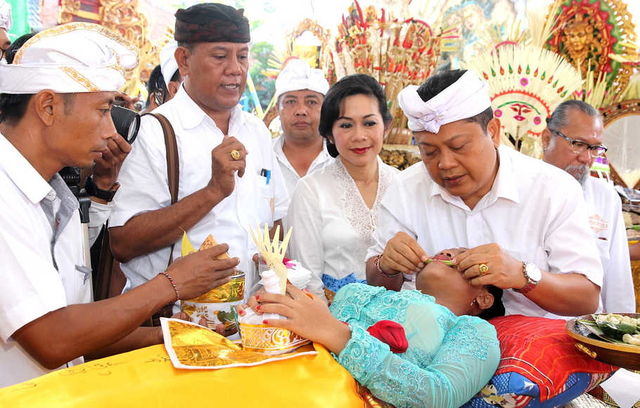
According to tradition, it is most favorable to invite a priest from the Brahmin caste to perform such a ceremony. However, in the present time, people from lower castes entrust the tooth filing to balians - the lower caste shamans. While the physical act of filing is significant, greater emphasis is placed on the spiritual aspect of the ritual, which involves combating the six negative habits known as 'sad ripu' or 'six enemies.'
Balinese people believe that human behavior is influenced by three 'gunas' or qualities. 'Guna Satvam' generates calm, peaceful behavior, honesty, wisdom, righteousness, and proper conduct. 'Guna Rajas' produces dynamic, lustful, and aggressive behavior. 'Guna Tamas' makes a person passive and lazy.
It is believed that the 'six enemies' are the manifestations of the last two gunas, which lead a person to sorrow and suffering in both this world and the hereafter. Among them are:
- 'Kama' (lust)
- 'Loba' (greed)
- 'Krodha' (anger and irritability)
- 'Mada' (intoxication and madness)
- 'Moha' (confusion and arrogance)
- 'Matsarya' (jealousy and envy)
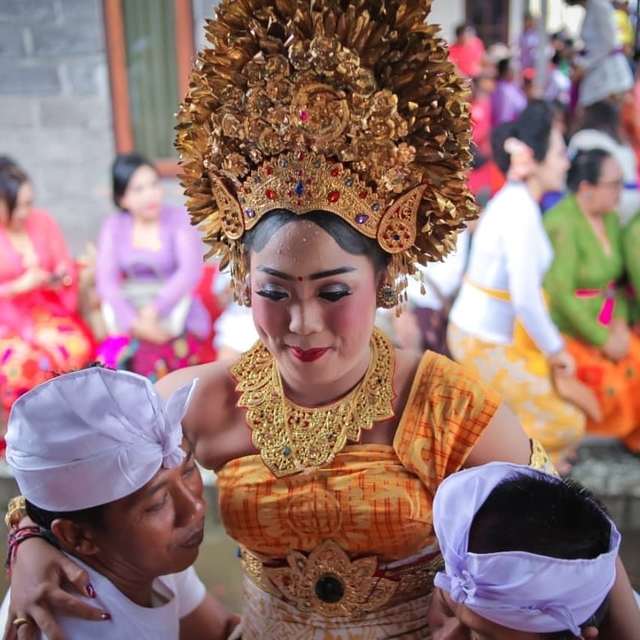
If a person diminishes the influence of these six shortcomings within themselves, they can lead a healthy and balanced life, becoming a kind member of their family and community, and their behavior will ensure a positive reincarnation in the subsequent life.
In the Balinese bamboo scripture, the 'Puja Kalapati,' it is written: 'A person who has not undergone 'mepandes' will not be able to encounter the spirits of the ancestors who have become holy.' In the 'Atma Prasangsa' scripture, it is stated: 'The spirits of those who have not undergone the tooth filing ceremony will be punished by the god Yamadhipati.' And in the 'Smaradahana' scripture, it is mentioned that Bhairava Gana, the son of Lord Sang Hyang Shiva, couldn't defeat his enemy, the giant Nilarudraka, until one of his fangs broke.
It is considered appropriate to spend a significant amount of money on the ceremony, decorate the house, invite guests and musicians, and make expensive offerings.
The matatah ritual has influenced Balinese aesthetic perception. The majority of Balinese people, even in our times, do not consider ordinary teeth with fangs as beautiful. The patron deity of this ritual is the god of beauty, Dewa Karma or Sang Hyang Semara Ratih. He encompasses both the masculine and feminine aspects.
Furthermore, it is believed that Dewa Karma brings success in all endeavors, heals illnesses, wards off evil spirits, and brings beauty to flowers.
The place where matatah is performed is called the 'bale gading,' which translates to 'ivory pavilion.' 'Gading' means 'ivory,' but it also refers to 'fangs.'
Balinese people are convinced that besides helping overcome the 'six enemies,' this ceremony makes a person more attractive to the opposite sex.

Whenever Balinese people determine the date for 'matatah,' they consult with a priest to find an auspicious day. Once the date is set, an invitation list is created. As this is a significant event, the number of guests can reach up to a hundred or even more individuals.
Of course, depending on the family's resources, the number of guests and the scale of the event can increase or decrease.
Quite frequently, the following rituals are included in the 'mepandes':
'Magumi Padangan' - conducted in the kitchen, indicating that a Balinese individual entering adulthood will need to manage household responsibilities.
'Ngekeb' - involves a person's commitment to control their impulses, particularly negative ones.
'Mabhyakala' - a ceremony held in the home courtyard, aimed at purifying a person from negative elements of 'Bhuta Kala,' which can arise both within and external to the individual.

Additionally, ceremonies related to tooth filing encompass important stages such as:
- A request to the deity Hyang Guru for permission to conduct the tooth filing ceremony.
- Paying homage to parents through prostration, embodying the deities Sang Hyang Uma and Shiva as the ultimate mother and father.
- Seeking holy water (Memohon Tirtha) as a symbol of prosperity, happiness, and immortality.
- Ngrajah gigi - the symbolic application of divine marks onto the teeth, guiding a person through life and ensuring proper conduct.
- The actual tooth filing.

On the day of the ceremony, the pavilion, known as 'bale,' in the family courtyard is adorned with festive golden cloth. Guests arrive with gifts and are offered refreshments while simultaneously preparing celebratory food.
The central participants of the ceremony, those who will undergo tooth filing, are dressed in the most exquisite traditional attire. Young men wear 'songket' - a golden brocade 'sarong' paired with a ceremonial dagger known as 'kris.' Young women wear traditional Balinese 'kamben' skirts, layered around their bodies. Their heads are adorned with gilded crowns adorned with flowers. Both young men and women may also wear makeup.
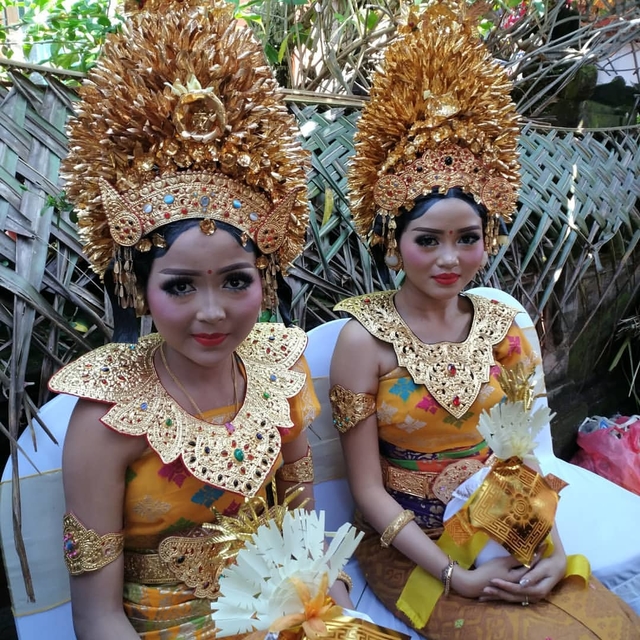
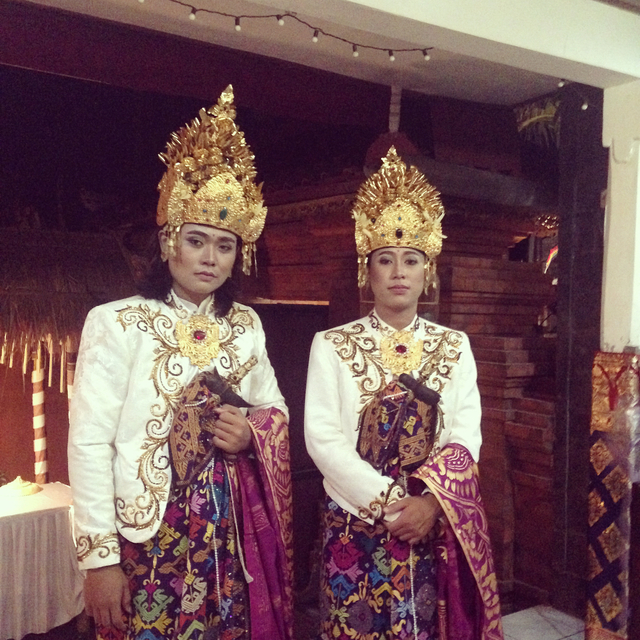
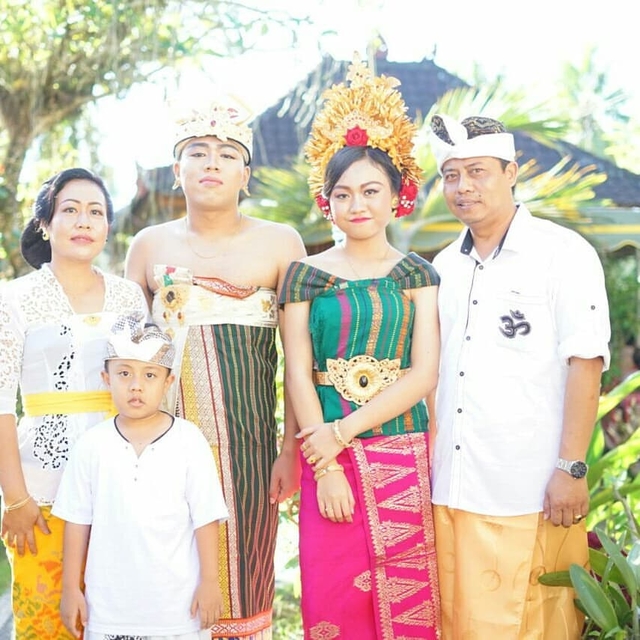
The priest blesses the participants with holy water. It is believed that during the ceremony, the teeth are temporarily 'killed,' creating a moment of vulnerability for the participants, who require special protection throughout the ritual. Hence, friends and family stand by, providing support to the participants, warding off evil spirits.
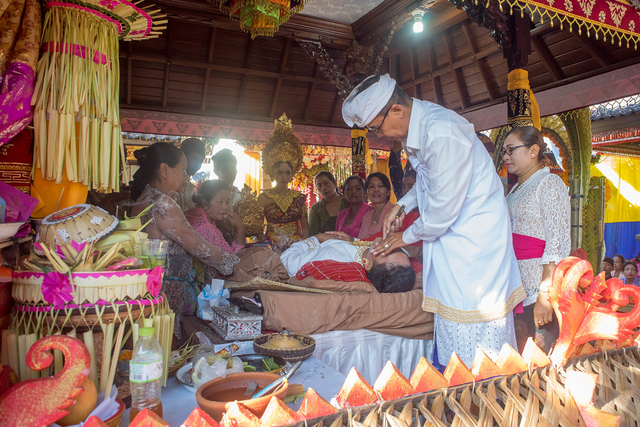
The priest opens a yellow coconut, pours water from it, and draws the magical symbol 'om' on it. Tools are set out, participants rinse their mouths, and an offering called 'chanang oyodan' is made to the gods. Participants hold their hands in a prayer pose at their chests to receive blessings. Young men set aside their 'kris' daggers. Participants remove their sandals, lie down, and receive mantras and the blessing of holy water. After this, they are covered with ceremonial cloth. The 'sangin' places a small cylinder made of sugarcane in the participant's mouth to keep their jaws open.
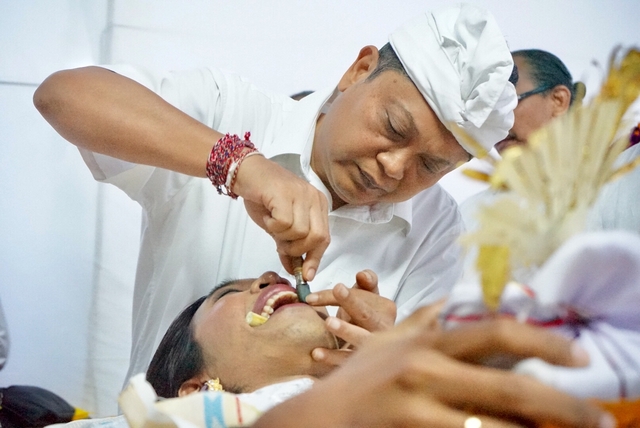
The 'sangin' may joke with their 'patient' to distract them from any unpleasant sensations.
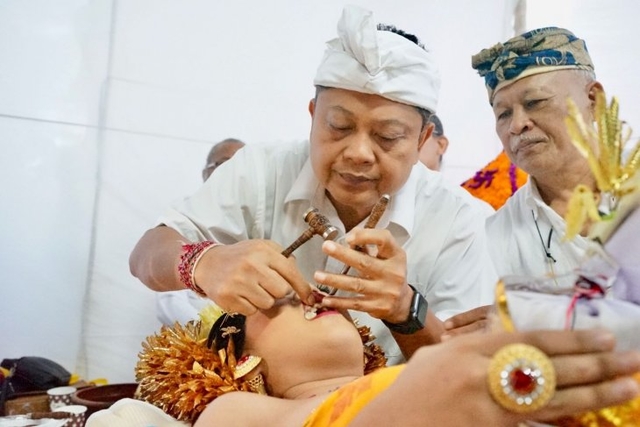
Only the upper teeth are filed - two canines and four incisors between them. A total of six - precisely one for each of the six negative qualities in a person.

The extent of tooth filing is left to the participant's discretion. The procedure can be purely symbolic, involving a couple of passes with the instrument. Some individuals utilize this ritual for a genuinely significant alignment of their tooth line. In such cases, the priest periodically provides a mirror to the participant to allow them to monitor the outcome.
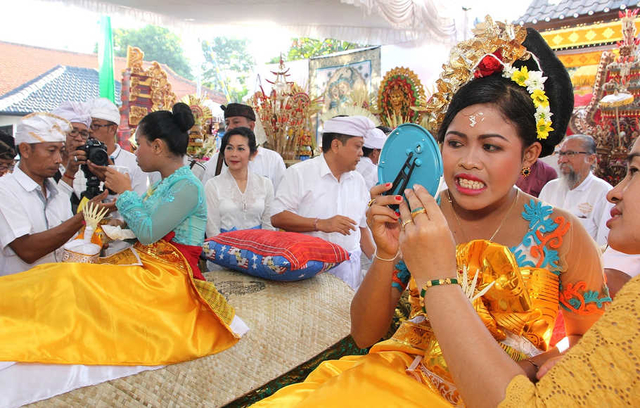
After the procedure is completed, participants spit into a yellow coconut. If there is bleeding, the priest uses a betel leaf. Following a symbolic ceremony to invigorate the teeth with a mantra, participants rinse their mouths with a mixture of honey, sandalwood powder, lime, turmeric, areca nut, betel leaf, gambir, and water. Some of the mixture is swallowed, while the rest is spat into the coconut.
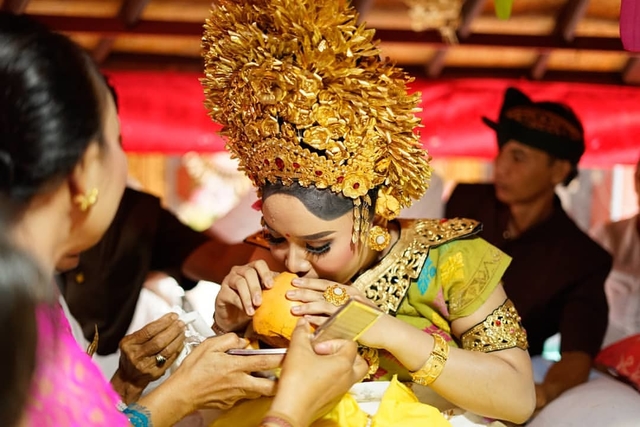
Next, it is considered appropriate to change clothes before continuing with the ceremonies, as it is believed that the previous attire symbolically underwent a 'death' ritual. Then, prayers are conducted in the family temple.

After the ceremony, the participant is fed a special dish called 'padamal,' which combines six tastes - 'pait' (bitter), 'manis' (sweet), 'pakeh' (salty), 'lalah' (spicy), 'masem' (sour), and 'nyangluh' (roasted). And for the next three days, the participant abstains from consuming hot food.
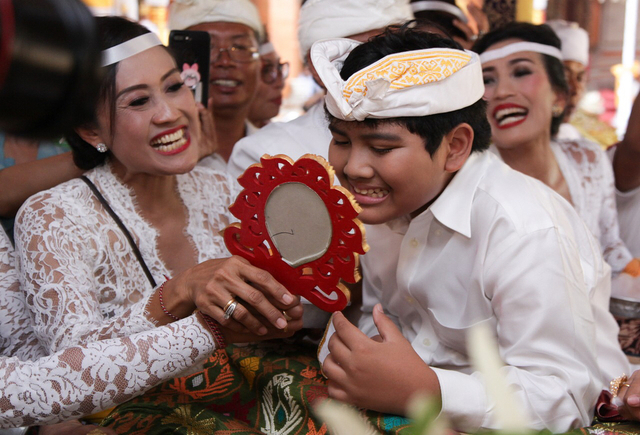
The yellow coconut from the ceremony should be buried near the family temple, which is believed to ensure that its power remains close to the participant throughout their life.
You can add one right now!